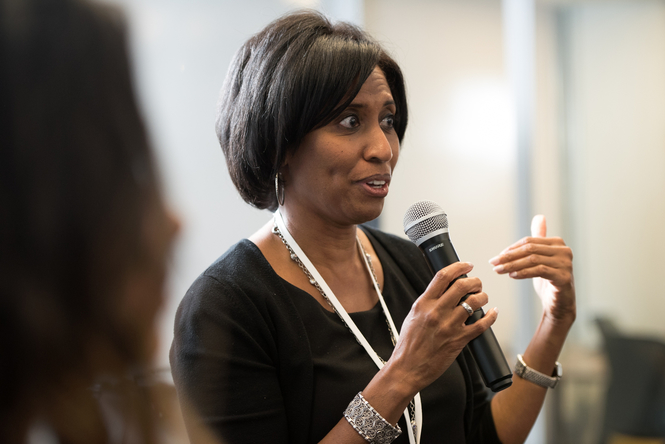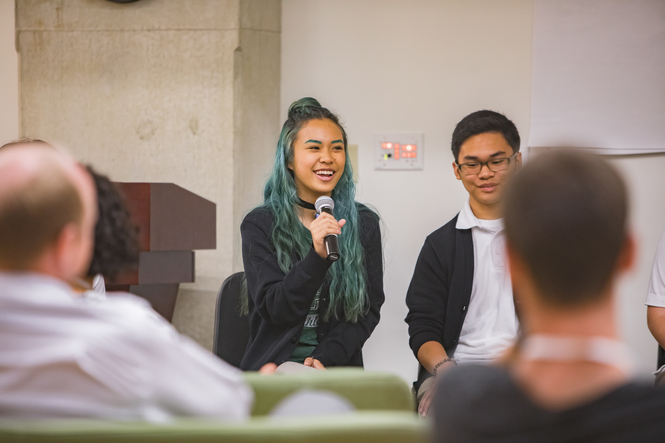Building Community
What is Network Leadership?
Topics

When educators design and create new schools, and live next gen learning themselves, they take the lead in growing next gen learning across the nation. Other educators don’t simply follow and adopt; next gen learning depends on personal and community agency—the will to own the change, fueled by the desire to learn from and with others. Networks and policy play important roles in enabling grassroots approaches to change.
A number of leadership roles in a collaborative/networked view of education together create a culture for connections to flourish.
“Network entrepreneurs are keenly aware that they are few among many working across the larger system, and in this way they embody a special type of … leader[ship].”
–Jane Wei-Skillern, David Ehrlichman & David Sawyer, “The Most Impactful Leaders You’ve Never Heard Of”
In the previous post in this series, Structure Matters, we considered how structure has implications for the extent to which a network or networked activity is able to leverage different kinds of net effects and create robust value for diverse participants. We also considered how structure has implications for both equity and how power is distributed. Another important consideration in how to create equitable benefit is what leadership looks like and how it plays out in and around networked activity.
The concept of leadership seems to be undergoing a rapid evolution lately. Especially in this “network age” there appears to be both a growing appreciation that leadership has always been about more than the singular and highly visible heroic individual, and that going forward, leadership must be upheld as much more of a shared and multi-dimensional endeavor.
“Leadership for this era is not a role or a set of traits; it is a zone of inter-relational process. Step in, step out.”
–Nora Bateson, Small Arcs of Larger Circles
In much of the collaborative consulting work that I do through the Interaction Institute for Social Change, leadership (or what we at IISC often call Facilitative Leadership) is about “holding the whole.” That is, there is a need for groups, teams, organizations, and communities to think more expansively about the state of a given complex system (community, economy, food system, organization, school, school district) and pay attention to what is required to support resiliency and/or change for more equitable and sustained benefit. In these situations, the traditional top-down images of leadership fall short.
In education, for example, we have seen hopes often pinned on seemingly superhuman teachers and principals who are brought in to “rescue failing kids and schools.” The assumption underlying such moves is that these extraordinary individuals will of their own drive and volition beat the odds and dramatically reverse some kind of downward trajectory. This story may be the making of a box office smash, but in reality is met with mixed results at best. This is not to say that individuals cannot provide crucial sparks at important moments in organizations and communities. But holding out for heroic singular leadership ignores the systemic reality of what got us to where we are in the first place, and denies the more complex and connected response that is actually required.
“Leadership is helping to make the network smarter.”
–Harold Jarche from his blog
Network leadership is at its best a dynamic, diverse, and multi-dimensional phenomenon. Many of those with whom my IISC colleagues and I have partnered in the work of social and systems change understand this implicitly, and we have found it can be helpful to externalize and be more explicit about this by naming some of the roles that leadership can embody in a collaborative/networked world.
One over-arching and all-encompassing role, with a bow of recognition to June Holley for coining the term, is network guardianship. Network guardianship is first and foremost about promoting and modeling fundamental network values such as transparency, openness, respect, generosity, and mutualism, all of which contribute to the creation of conditions that can nurture strong connections, robust flows, net effects, and shared value. Many if not all the important roles in networks contribute to establishing a collaborative and trusting culture. This culture is important to create and protect, especially at the outset of an initiative (in a food justice initiative we referred to the early convenors of the network as “network gardeners“), though it is also important to keep networks from becoming too protected such that they become calcified or exclusive.
“In a P2P network community . . . everyone is involved in creating and working toward that same common purpose and vision, . . . everyone is equal and all are able to act.”
–Mila N. Baker, Peer-to-Peer Leadership
More specifically, there are a number of core roles or functions that we can put under the heading of “network leadership” that collectively serve to feed the soil and nurture collaborative cultures for connections and flows to flourish.
Convening
A convener is a person or group who has “convening power” and provides the social capital and connections to pull people together and some of the resources to support a given event or ongoing initiative (money, space, technology) and build the network. Conveners in our practice are often foundations, municipal governments, academic institutions, and community-based organizations. A well-connected and trusted individual can also be a convener. This role includes championing the cause, raising awareness, and making the initial and ongoing invitation to come together.
Design (of Process and Structure)
The “design team,” in IISC’s practice, is comprised of a diverse group of people representing different parts of the system upon which an initiative is focused. This team maps out a pathway of activities that help to move a wider group of actors from relative disparateness to cohesion and in many cases from vision to action. And an individual volunteer can serve this role in other contexts. Designers take on and enjoy the creative endeavor of fashioning experiences that enliven and bring out the best in a diversity of people, including the creation of space for difficult conversations and building trust. Designers also think carefully and critically about structures and supports that will facilitate equitable access and value through and in a network or networked activity, whether in-person or on-line.

Facilitation
A facilitator is a person or team of people that stewards the overall process of network development and activation or individual events as part of that ongoing process. Facilitators hold the space for difficult and productive conversations, listen to the wishes and wisdom of those who are convened, help to build alignment and agreement (if needed/desired), support self-organized activity, and balance structured discussion with openness for emergent possibilities. Ideally facilitators are also able to deftly address power dynamics and create spaces for diverse and equitable participation and belonging.
“Both evolution and innovation thrive in collaborative networks where opportunities for serendipitous connections exist.”
–Steven Johnson, Where Good Ideas Come From
Weaving
According to June Holley in : “A network weaver is someone who is aware of the networks around them and explicitly works to make them healthier. They do this by helping people identify their interests and challenges, connecting people strategically where there’s potential for mutual benefit, and serving as a catalyst for self-organizing groups.” In >span class="MsoHyperlink">one particular network initiative that I support, there is a group of funded individuals called “Ambassadors” who are charged with reaching out to under-represented and often marginalized groups. Weaving supports the creation of internal group coherence (bonding) and small world reach (bridging to adjacent groups and networks) with a mind toward creating value for individual participants and the broader collective.
Communications and Curation
Communications in social change networks can be a nuanced and complex role, not necessarily the same as organizational communications. It is about helping to create and fill a variety of channels (one-to-one, one-to-many, many-to-many) so that people can stay connected, share freely, and learn in timely ways. In many cases, it is also helpful to have a role or roles committed to content curation—soliciting, aggregating, distilling, highlighting, and organizing an abundance of information and other resources to keep people engaged, seeking, and sharing and keep the network humming.
Provocation/Thought Leadership
Being a provocateur can be an informal or formal role, and is often filled by a person or people who can ask the otherwise unasked questions. The provocateur challenges a group or initiative when it is reaching agreement too easily or getting too comfortable and safe with its work and thinking. Often provocateurs and thought leaders are found in those at the periphery of networks or who span boundaries of various kinds.

Coordination
Network coordination often comes down in large part to creating and maintaining a support infrastructure, scheduling common meeting times, and ensuring that people have access to relevant resources. Especially in complex action-oriented networks this is a crucial function, without which things can quickly unravel!
Implementation/Prototyping
What exactly constitutes “implementation” can vary from network to network. This might be about putting into action a shared and structured “strategic plan” of some kind through formalized work groups. But it can also look like individuals experimenting with and honing nascent and promising ideas as they emerge through learning and conversation. Sometimes prototyping occurs at the “edges” of larger formalized projects through spontaneous new partnerships (such as task teams and communities of practice) forming and trying out new things—this is self-organization, where the magic in networks often happens.
Governance
This is the function that many people want to turn to first in multi-organizational collaborative networks. How will we make decisions? How will we develop policy or make strategic choices? How will we get things done? Valid questions, and if the default is a traditional governing board structure, or a steering committee, it can limit network potential. Sometimes that is what is called for, and as my friend and fellow network enthusiast Jessica Lipnack has said, “You only need enough structure to facilitate conversation and make crucial decisions.” Less is more, and structure can be fluid. A network principle that I find helpful to invoke is that of subsidiarity in governance—>span class="s2"> matters ought to be handled by the smallest, closest to the ground or least centralized competent “authority.”
Consider this a starter list of important roles and functions, to which I’m sure others would add. They are not necessarily all present or present at the same time or in the same way in all networks. And regardless of which ones are activated, they all benefit from an orientation of making the whole greater than the sum of its parts.
What does leadership look and feel like in your school-based and education-oriented networks and networked activities?
Which roles and functions are present? Which ones are missing that might create more value?
What could be done to grow and spread network leadership for equitable and enhanced benefit?
Next Generation Learning Challenges invites you to respond to these ideas about network effects in education and learning. Please comment below and join the conversation in the NGLC Networks for Learning group on LinkedIn. The group asks how we design our networks, how we act within and across them, what we know works well, and how they can best drive future learning shifts in K-12 education. Learn more on the NGLC Networks for Learning site.
Photos, from top:
- “3D Star Map” (Taro Taylor, via Flickr)
- Phyllis Lockett of LEAP Innovations facilitates a network meeting in Chicago, September 2015 (NGLC)
- Students at e3 Civic High in San Diego speak to a group of educators visiting their school on a trip coordinated by Next Generation Learning Challenges, October 2017 (NGLC)




